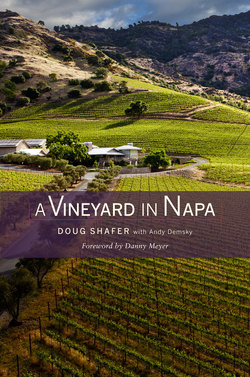Читать книгу A Vineyard in Napa - Doug Shafer - Страница 11
На сайте Литреса книга снята с продажи.
ОглавлениеTWO
January 1973
There must be a million American stories that begin with a family packing themselves into a station wagon.
I can still remember my dad at the wheel of our wood-paneled Country Squire flying west on I-80. He was trim and handsome, his hair thinning a bit on top. My younger brother Brad, twelve, was in the backseat with our dog, Dingo. I was riding shotgun, a lanky, basketball-obsessed seventeen-year-old who wore glasses. On that gray, frigid day in January we’d packed into our car and started driving toward California.
The sense of adventure is hard to overstate. The only home I’d known was our three-story Victorian in genteel Hinsdale. This was going to be the longest trip I’d ever taken by car.
As the skyline of Chicago receded in our rearview mirror and the vast American heartland spread out before us, it was like finding ourselves in a huge novel on page one.
Like any good road story, within hours we ran into trouble, which began as drifting, popcorn-sized snowflakes. A charming flurry turned into a white pummeling and then a violent blur. Long stretches of interstate were hit hard with snowstorms, and we inched along, hoping not to slide off into a snowbank, praying not to smash into the back of a stalled truck. Each evening, as the trip continued, we stopped at a different white-blobbed, featureless motel and snuck Dingo in with us for the night. (My mom, who was probably smarter than all of us, was flying out and would meet us in San Francisco. My older siblings, Bill and Libby, were in college and missed all of this.)
Each day we crawled closer to that 200 acres of vineyard in a place called Napa Valley. As he drove, Dad’s mind was on grape prices, vine cultivation, the future of the wine industry, and a thousand other things.
My seventeen-year-old brain was absorbed with—what else?—my social life. In Chicago I’d gone to Hinsdale High, a big school, where I’d been a pretty small fish, although I’d gained a little late-game cachet as the kid who was moving to California, which my friends and I envisioned as a sunny partyland, where it was going to be Malibu and beaches and bikini time. I had high teenage hopes for life in the Golden State.
As such, this complete uprooting of our family and our lives didn’t seem traumatic or unwelcome. If anything, it felt very much a part of the ethos of the times. Just as my dad’s early life was molded by the Depression, mine was shaped by the change going on all around us. By 1973 America had been to the moon, schools were still working on racial integration, and teenagers were listening to acid-inspired rock. Meanwhile, there was still a whole generation of grandparents who had been born in the 1880s and 1890s. (My great-grandfather Coates Foresman had only passed away a couple years prior to all this.) When their parents had traveled west, it had been Little House on the Prairie-style in ox-drawn wagons and later by steam locomotive. They had played banjoes and split rails.
One generation was slowly and uneasily handing the reins to another. Former president Harry Truman had just passed away in Kansas City, Missouri, in the week after Christmas, following a long illness. A few weeks later, former president Lyndon Johnson died unexpectedly of a heart attack. President Nixon had just won reelection and was sworn in for his second term on January 20; he was all smiles despite a news story that was just showing up in newspapers about the “bugging trial,” which was later dubbed “Watergate.”
As 1973 began, the United States had stepped up a bombing campaign in North Vietnam, but by January 20 a peace pact was signed, and it looked like the POWs would start coming home within weeks.
On the way to California we passed movie theaters showing The Godfather and The French Connection. When my mom flew to California she’d be one of the first airline passengers to pass through the newly mandated security systems designed to stop hijacking. (New Trier High alum Charlton Heston was starring in a now-forgotten but timely movie called Skyjacked.)
Looking back, I believe we were caught up in another element of that time: the “back to the land” movement. The hippie version of that was to join a commune, surround yourself with goats and naked toddlers, learn the dulcimer, and grow some pot. Others were starting the organic farm movement and creating food co-ops.
According to one study, in the 1970s more than one million people in Canada and the United States engaged in this reverse migration from the city to small rural farms.1
The Napa Valley version of that movement brought Jack and Jamie Davies from Los Angeles to Napa Valley to start Schramsberg. It brought the Brounsteins of Diamond Creek, the Trefethens, the Duckhorns, and Gary and Nancy Andrus of Pine Ridge. Jim Barrett came from Los Angeles to breathe life into Chateau Montelena, Joe Phelps was lured away from his construction business in Colorado, and Warren Winiarski left a professorship in Chicago to launch Stag’s Leap Wine Cellars. Men and women from diverse walks of life were drawn to this place in the late 1960s and early 1970s and committed everything they had to pull Napa Valley out of its long doldrums.
1. Jeffrey C. Jacob, “The North American Back-to-the-Land Movement,” Community Development Journal 31, no. 3 (July 1996): 241–49.
